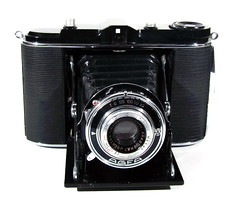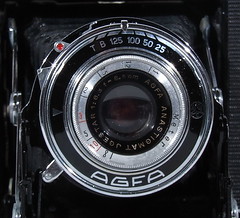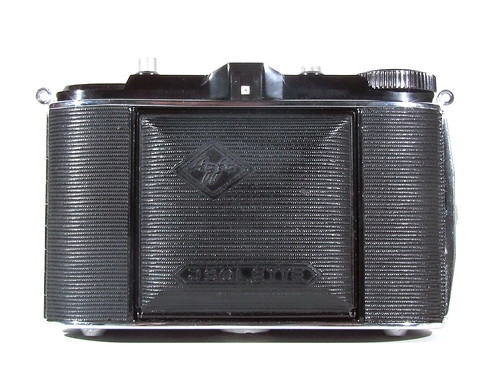Isolette
The Isolette (embossed in the leatherette as JSOLETTE)[1] is a horizontal-folding camera for twelve 6×6 cm (2¼-inch square) pictures (or sixteen 4.5×6 cm (2¼×1⅝ inch) pictures, with the first model of the camera) on 120 film. It was made by Agfa Kamerawerk AG, Munich, Germany, from 1938.[2]
It first came on the market as the Isorette (again, appearing as JSORETTE on the camera), but the name was changed to Isolette within a year.
There are two distinct models of the first Isolette series: the early one (before and during the Second World War) and the post-War one.
Isolette (1938-42)
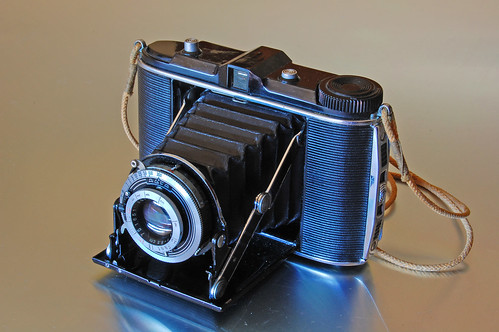
|
| First model Isolette. image by Raúl Sá Dantas (Image rights) |
This first model was a dual format camera: by using 2 internal masks it could be changed from the 6x6cm format to the 4.5x6cm format. There is also a mask for the viewfinder.
One of the distinctive features is the top housing made of a plastic called "Trolitan"; the post-War camera has a cast aluminium top housing. This camera also has loops to attach a strap, the only version of the Isolette to have these. Different lens and shutter combinations were available, allowing a wide range of levels of specification. This model was called the "Soldatenkamera" (soldier's camera) in Germany during the War.
- Year of release: 1938[2]
- Film Format: 12 exp. 6x6 or 16 exp. 4.5x6 on 120 type rollfilm.
- Shutter: Vario, Pronto, Prontor II, Compur or Compur-Rapid.
- Lens: Igestar 8.5cm f/6.3, Apotar 8.5cm f/4.5 or Solinar 8.5cm f/4.5.
- Viewfinder: reverse-Galilean viewfinder
The earliest cameras have Vario shutters which are not labelled as such.
|
|
| ||||||
| Isolette, first model, about 1938.
Images by Süleyman Demir (Image rights) | ||||||||
Isolette (1945-50)
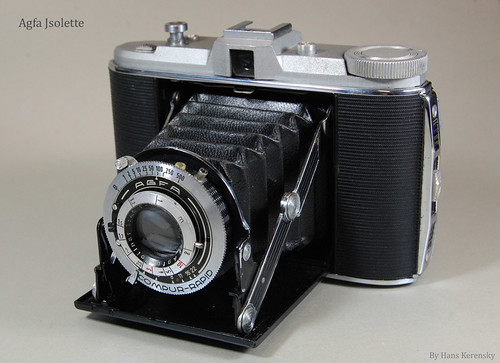
|
| Post-War Isolette image by Hans Kerensky (Image rights) |
The late model was made from 1945 till 1950. The top housing of this model is cast from Hydronalium (Nüral: an aluminium alloy). There were different lens/shutter combinations possible. Other changes from the early model are to one film format only (6x6) and the addition of an accessory shoe (above the viewfinder).
- Year of release: 1945
- Film Format: 12 exp. 6x6 on 120 film.
- Shutter: Prontor, Prontor-S or Compur-Rapid.
- Lens: Apotar 8.5cm f/4.5 or Solinar 8.5cm f/4.5.
- Double exposure prevention.
- Viewfinder: reverse-Galilean viewfinder
Succeeding models
After 1950, several different models of the Isolette were made at the same time, with different levels of specification:
- the Isolette I
- the Isolette II
- the Isolette III
- the Isolette V
- the Super Isolette
- the Isolette L
Notes
- ↑ The name is written as Jsolette simply because the capital "I" resembles a "J" in German typography of the time. The embossing on the camera was changed to a modern "I" in 1937. See: Old German Letters
- ↑ 2.0 2.1 McKeown, James M. and Joan C. McKeown's Price Guide to Antique and Classic Cameras, 12th Edition, 2005-2006. USA, Centennial Photo Service, 2004. ISBN 0-931838-40-1 (hardcover). ISBN 0-931838-41-X (softcover). p25.
